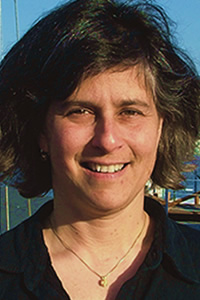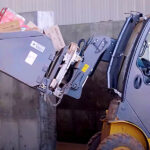
Sally Brown
BioCycle September 2015
Soil and water are not at all like oil and water. They do mix. Mixing the two has produced some classic combinations. Mud pies are just one example. These pies are so famous that they even have a range of recipes named after them. All mud pie recipes contain different amounts and types of chocolate, making them a culinary step up from the original. Soil and water also have a wide range of overlap in ingredients and chemical properties. For example both contain oxygen, pH is a critical measure for both and each often contain a bit of the other. Soil in streams is called sediment and water in soil is referred to as “green water.” Both also are typically subject to a range of regulations developed to protect human and ecological health.
Recently, an attorney asked me to compare these two sets of regulations. I could tell that he was feeling pretty clever, having realized that the water and soil regulations have a great deal of overlap in what is regulated. What he and many others don’t realize is that compounds in soil can behave very differently than the same compounds in water. Try to apply water standards to soil or soil standards to water and you have a disaster — like substituting actual mud for chocolate in a mud pie recipe. This column gives you the basics on those differences.
Let’s start with a description of the basic differences between soil and water. While water may have some suspended sediments (i.e., soil), the vast majority of what living creatures come in contact with is water. And while soil may have some water, the vast majority of what is contained in it is mineral matter. For 1 kilogram (kg) of water, if there are any more than 50 grams of soil, you get brown soup. That is the same as 95 percent water and 5 percent soil.
For 1 kg of soil, if you have more than 300 grams of water, you get mud. That is 70 percent soil and 30 percent water. The ideal amount of water in soil is referred to as “field capacity” — the condition when all free water has drained from the soil and there is enough water for plants but enough empty space so that air can move in as well. For a normal soil, that is about 35 percent water by volume. By weight, that means that for every kilogram of pure soil you have 180 g of water.
Regulated Compounds
So what does that mean for regulated compounds? Start with nitrogen. In both soil and water systems, plants and animals typically get the nitrogen they need from what is dissolved in the water. Nitrogen comes in multiple forms with nitrate being the easiest to use. In Washington State, a total nitrogen concentration above 2 parts per million (ppm) in a freshwater stream is cause for concern. In water, almost all nitrogen measured in the stream is nitrate and it is all available. Therefore having more than 2 mg of nitrate in one liter of water is not good.
Soil is a different ballgame. Nitrate in soil solution (soil water) represents only a small fraction of total nitrogen. A typical soil (figuring 1.5% total carbon and about a 10:1 carbon:nitrogen ratio) contains about 4 tons of nitrogen per hectare, or 2,000 ppm. A stream with that total N concentration would have so much algae it would be a slime pit. In a soil, it is likely additional N is required to get a decent crop. A crop of hay in Washington State with a weight of 6 tons per hectare contains about 100 kg of total nitrogen (about 50 ppm). That is just about the amount you would add as fertilizer and again enough to send freshwater into a tailspin. In other words, trying to apply water quality limits to soil for nitrogen makes no sense.
Regulated Metals
Water quality limits applied to soil also make no sense for metals. Copper is a big concern here in the Northwest. Salmon, our iconic fish, are sensitive to concentrations as low as 5 parts per billion (ppb). In aquatic systems, total copper and dissolved copper are often close to the same thing. For example, we recently tested different composts for use in storm water bioretention systems. Synthetic storm water with total copper concentrations of about 800 ppb was added to the columns. What came out — a mix of about 50 to 70 percent dissolved with the remainder attached to particles — was typically less than 50 ppb. Total copper in those same columns measured about 20,000 ppb.
So should we set limits for soil copper to meet the criteria that works for rivers and streams? That would involve having to remediate all of the soils in the U.S. Typically soil copper concentrations are 18 ppm (or 18,000 parts per billion). In a recent sampling, total concentrations of copper in U.S. soils ranged from 500 ppb to 996,000 ppb. Now I don’t recommend putting salmon in the soil. But if you did, it wouldn’t be the copper that killed the fish.
The vast majority of copper in soils is in solid form. Copper in soils can exist in different soil minerals, bonded to or as part of organic matter, and latched onto the surface of soil minerals. Only a very, very small portion of the total copper will actually be floating around in the water in soil solution. And even that small fraction is likely not all available. Some is attached to dissolved organic matter, some is bonded to other ions, and the remaining part that could impact the land locked salmon would likely be small enough to not cause a problem. It is also important to remember that plants that grow in soils need copper. While they don’t need it in big quantities, copper deficiencies can be just as bad for plant growth as nitrogen deficiencies. Even with the total soil concentrations of 18,000 ppb, most soil fertility tests are geared to detecting potential copper deficiencies rather than toxicities.
So while soil and water can and often do mix, leave the water standards for aquatic systems. For those who work in these systems and consider soils (and composts and biosolids) as a potential threat to these systems, recognize that understanding reactions and concentrations in soils is a much more complex process than the same processes in water. Finally, remember to use good chocolate and not soil when you make your mud pies.
Sally Brown is a Research Associate Professor at the University of Washington in Seattle and a member of BioCycle’s Editorial Board.












